
Transit Briefs: Amtrak/NC By Train, NYMTA, VIA Rail, The City of Calgary, SBCTA/LA Metro
Written by Carolina Worrell, Senior Editor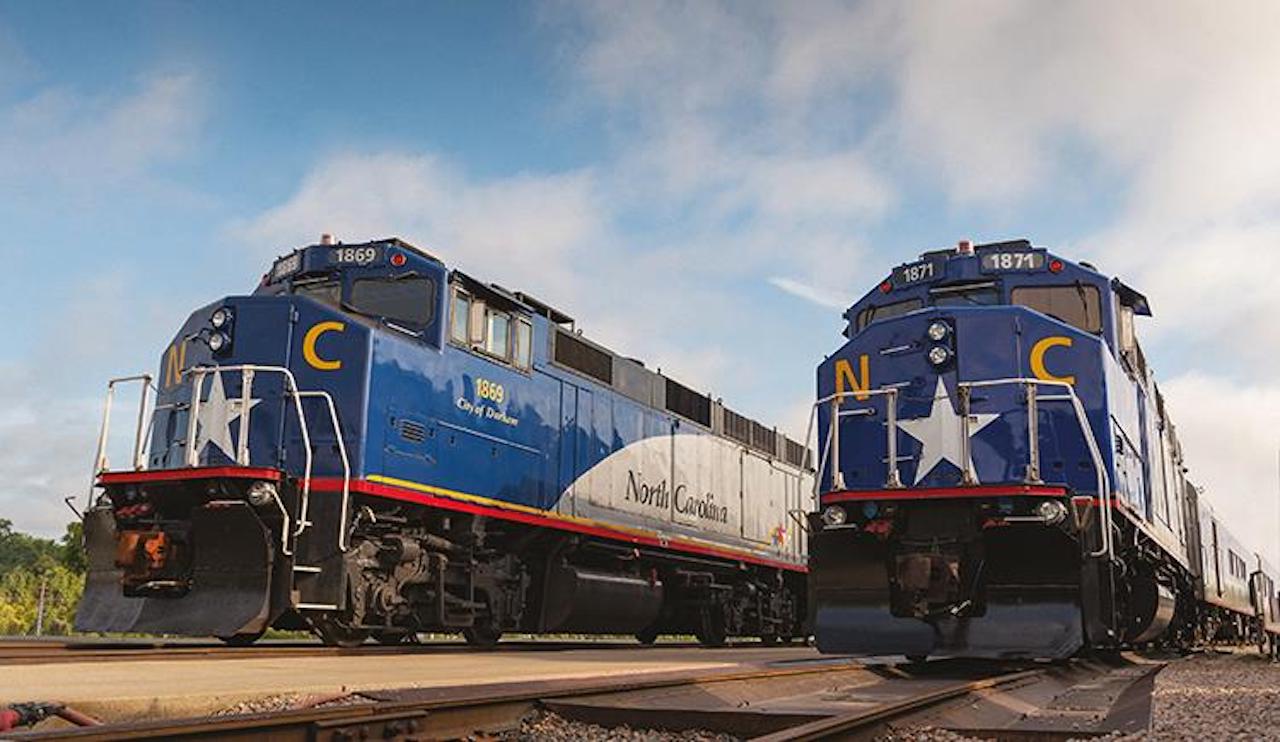
NC By Train photo
Amtrak and NC By Train announce that the Piedmont and Carolinian will now offer five daily roundtrips between Raleigh, Charlotte, and points in between. Also, the New York Metropolitan Transportation Authority (MTA) announces a new customer real-time email and text alert system; VIA Rail Canada (VIA Rail) breaks ground on construction of Toronto Maintenance Center; The City of Calgary announces that it will undertake a new Calgary Airport Connection Study; and the San Bernardino County Transportation Authority (SBCTA) and LA Metro will study expanding rail frequency from Redlands to LA Union Station.
Amtrak/NC By Train
To meet the growing demand for train service, Amtrak and NC By Train announced July 10 that the North Carolina Department of Transportation (NCDOT) sponsored Piedmont and Carolinian, which travels daily from New York to Charlotte, will now offer five daily roundtrips for travel between Raleigh, Charlotte, and points in between.
According to Amtrak, customers now have more flexibility, including:
- Ten daily departures.
- A new 1 p.m. departure from Raleigh.
- A new 5:30 p.m. departure from Charlotte.
- Schedule adjustments departing Charlotte: 2:20 p.m. and 7:45 p.m.
In addition to serving Raleigh and Charlotte, the Piedmont and Carolinian also stops in Cary, Durham, Burlington, Greensboro, High Point, Salisbury, and Kannapolis. The Carolinian continues through eastern North Carolina with stops in Selma, Wilson and Rocky Mount and then on to Virginia, Washington, D.C., and the Northeast.
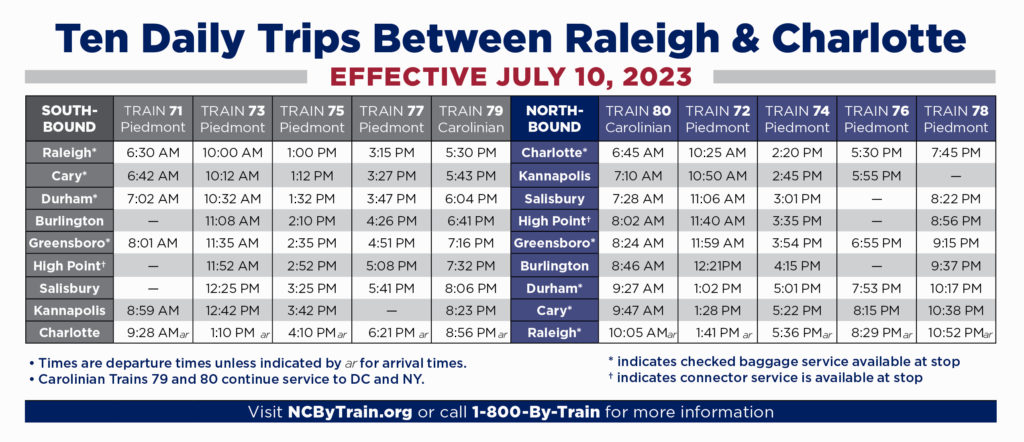
“Our state’s rail service is top-notch and I’m grateful for this partnership with Amtrak and NCDOT,” Governor Roy Cooper said. “These additional service options will help North Carolinians get where they need to be.”
The additional NC By Train services are fueled by the record ridership the state has experienced during the past year. In 2022, ridership aboard NC By Train was the highest in its 32-year history.
“The increase in ridership in 2022 and the beginning of 2023 shows that people love NC By Train and want more,” said Transportation Secretary Eric Boyette. “We’re happy to provide our customers with more trains and new schedule options.”
The Piedmont began service in 1995 with one daily round trip. Ridership has increased to approximately 300,000 passengers annually.
“North Carolina is making substantial investments to expand and improve passenger rail,” Amtrak President Roger Harris said. “It is a pleasure to partner with North Carolina to bring train service to the region and an honor customers trust us for a vital and sustainable way to travel.”
To celebrate the new service, NC By Train is offering a 50% off promotion that will run through the end of July. In addition to the 50% off regular price adult tickets on Piedmont and Carolinian routes in North Carolina, NC By Train is currently featuring $5 Kids Summer Fare through Labor Day. Share Fare is a discount feature which allows groups of up to eight people to save money with each additional ticket that is purchased. Daily discounts for children, students, seniors, active military, and state employees are also available all year long.
NCDOT encourages people to take advantage of the “comfortable, convenient transportation” available on NC By Train with its large seats, charging outlets at each seat and free WiFi.
NYMTA
The New York MTA on July 10 announced that its new MTA Service Alerts system is now live for customer use.
According to the agency, MTA Service Alerts was developed to provide customers with “timely, personalized updates on service impacting train, subway, or bus commutes, including delays, reroutes, and cancellations.” Elevator and escalator alerts and MTA Bridges and Tunnels alerts remain available in the legacy MyMTAAlerts system, which launched in 2007.
MTA Service Alerts provides customers with “maximum control over when and how to receive service updates,” the agency said. Customers can choose the day of the week and time periods for alerts, and whether to receive messages via SMS or email. Alerts are managed through a new subscription center, where customers can also sign up for MTA newsletters such as the MTA Weekender, a weekly newsletter sent every Friday to inform customers of weekend service changes throughout the transit system.
According to the agency, MTA Service Alerts deliver “impactful updates in fewer messages, which allows customers to sign up for tight windows tailored to when they travel.” Email alerts will now be formatted similarly to alerts customers already see on the website and in-system screens, with route bullets for impacted subway lines. Text alerts are issued from a new dedicated short code, 511-682 reserved exclusively for the MTA.
“New Yorkers are always on the move, and with MTA Service Alerts, MTA customers will be able to travel confidently with the most current information that may impact their specific journeys,” said MTA Acting Chief Customer Officer Shanifah Rieara. “This new approach to service alerts will ensure that we are communicating directly to customers about relevant service impacts consistently and simply across channels and will provide customers enhanced opportunities to receive timely updates on planned work.”
VIA Rail
VIA Rail on July 10 broke ground on construction at its Toronto Maintenance Center (TMC), which will provide a state-of-the-art facility for the agency’s new fleet of 32 trains in the Quebec City-Windsor corridor.
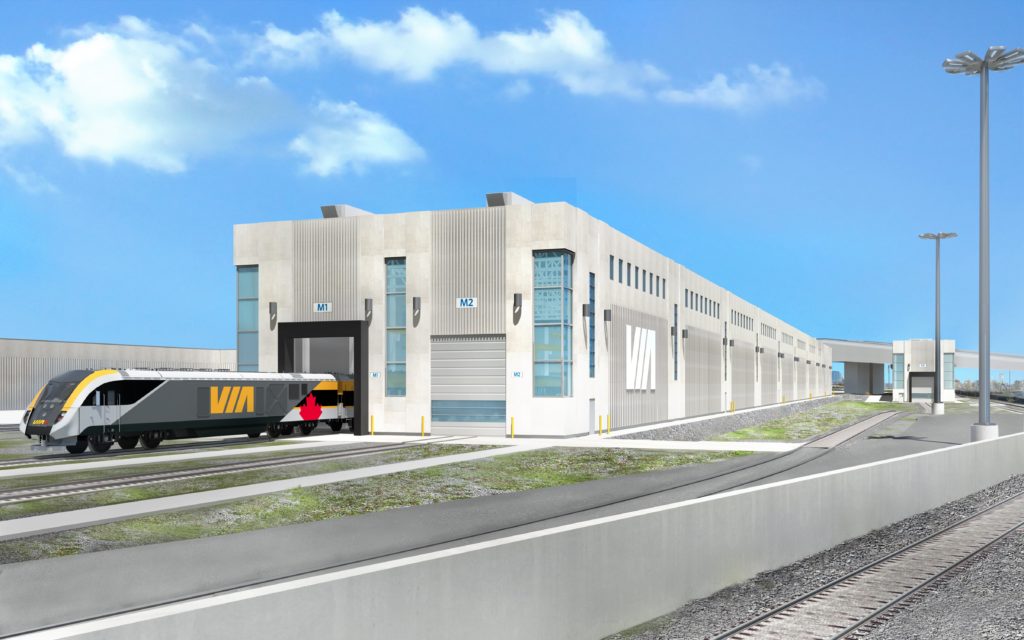
The modernization of the TMC, which the agency says is “an important pillar in VIA Rail’s large-scale modernization which aims to transform the way Canadians travel from reservation to destination,” protects the investment in the new fleet by increasing its longevity. The innovative Vehicle Equipment Measurement System (VEMS) will allow VIA Rail to improve proactive maintenance with an early warning detection system, ensuring any issues are dealt with “swiftly, safely, and without prolonged downtime,” VIA Rail said.
In keeping with VIA Rail’s vision to positively impact the communities it serves, the work will be conducted by Buttcon Limited, a construction firm with its head office in Woodbridge, Ontario, and will create up to 475 local jobs in the trade and construction industries between now and completion in 2026, according to the agency.
The scope of the work includes:
- The demolition of a portion of the existing structure and the construction of state-of-the-art facilities.
- Construction of a new addition, removal, and replacement of tracks.
- The addition of a stand-alone wheel lathe facility (to maintain wheels and ensure smooth operation on the tracks) and critical infrastructure improvements throughout the maintenance yard.
The funding of the modernization of VIA Rail’s maintenance centers, the implementation and integration of various Information Technology (IT) systems, as well as the transformation of maintenance processes, are all part of the funding for VIA Rail’s Fleet Replacement Program provided in the 2018 federal budget.
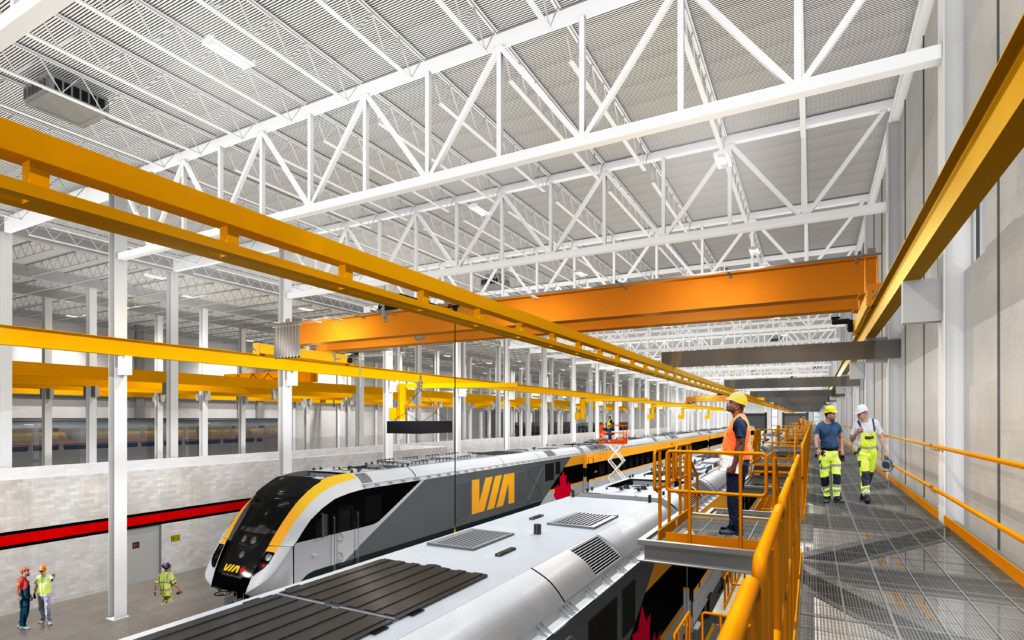
“This modernized maintenance center will support us in our mission to provide our passengers the most enjoyable travel experience and better connect Canadian communities,” said VIA Rail President and CEO Mario Péloquin “It will also allow our employees to work with the most modern equipment and will provide them the necessary tools to maintain the new fleet according to VIA Rail’s standards of excellence.”
“This pivotal step in our modernization process will allow VIA Rail to maintain the 32 trains of the new fleet that will offer an unparalleled customer experience for passengers travelling in the Québec City-Windsor corridor,” said Chief Business Transformation Officer Bruno Cacciola.
The City of Calgary
In partnership with the Government of Canada, The City of Calgary announced July 10 that it will be undertaking a study to identify the optimal rail connection and alignment between downtown Calgary and the Calgary International Airport.
As part of the 2023 budget, C$3 million in funding was allocated to The City of Calgary to lead the study, which will include a ridership review, development and evaluation of different alignment scenarios and will identify the optimal connection from downtown to the airport.
According to The City of Calgary, an engineering consultant will be recruited to assist with the technical study, which will also include engagement with Canada Infrastructure Bank, the Calgary International Airport, Canadian Pacific Kansas City (CPKC), and various private rail developers who are developing project plans to connect downtown with the airport and the surrounding region.
A request for proposals (RFP) is currently in market for an engineering consultant to assist with the study. Once a consultant has been selected through the competitive process, work is expected to begin in October 2023 and is expected to be complete in August 2024.
Recommendations from the study will ultimately be provided to Calgary City Council to help guide The City’s short to long-term transportation and land use planning.
“It’s important for us to take a comprehensive look at all factors in this technically and physically constrained corridor to establish an optimal functional alignment that will best serve Calgarians, visitors and employees of the airport and surrounding lands,” said Michael Thompson, General Manager of Infrastructure Services. “The study will consider existing rail plans, past City of Calgary transit studies and other opportunities, to help guide future transit planning.”
“As Calgary continues to grow, it’s vital to have a roadmap to build out a transit network that increases capacity and supports transportation needs, now and into the future,” said Minister of Transportation and Economic Corridors, Devin Dreeshen. “This project is an important step forward in providing direction on affordable transit infrastructure that will best serve Calgary, while respecting taxpayers’ investment.”
SBCTA/LA Metro
The SBCTA Board of Directors at the July 5 meeting approved moving forward with a cost-sharing agreement with LA Metro to have the Southern California Regional Rail Authority (SCRRA/Metrolink) conduct a study on extending multiple-unit rail vehicle service from the University of Redlands to Union Station in the City of Los Angeles.
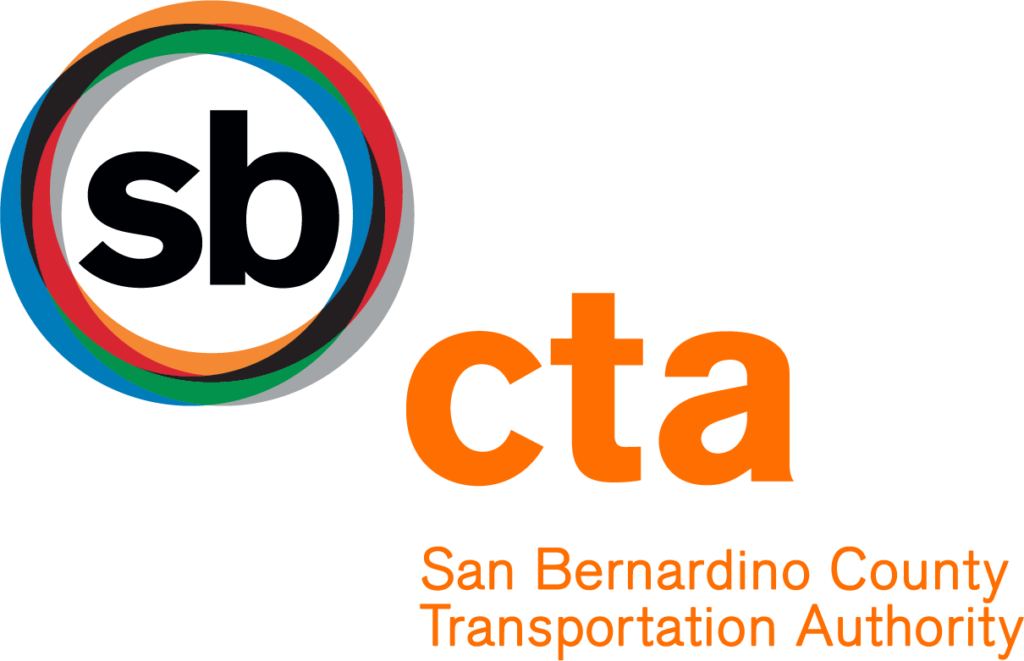
In 2018, the Hybrid Rail Study was completed in partnership with SCRRA, LA Metro and SBCTA to “analyze the feasibility and operating parameters for supplementing or converting existing Metrolink service on the San Bernardino Line with multiple-unit service.” The goal, SBCTA says, was two-fold: “reduce overall operating costs for rail service in the corridor and provide more frequent service with a focus on a convenient overall schedule for customers.”
SCRRA was awarded state grant funding for their Southern California Optimized Rail Expansion (SCORE) Program to make infrastructure improvements in the Metrolink system, with requirements that service frequencies be increased on the San Bernardino Line by 2028. SBCTA completed the Redlands Passenger Rail Project in 2022 and, in October, Metrolink began revenue service on the line between downtown San Bernardino and the University of Redlands using smaller, cleaner Diesel Multiple Unit (DMU) vehicles. Additionally, SBCTA will begin testing their Zero Emission Multiple Unit (ZEMU) vehicles in late 2023, with revenue service scheduled to begin by late 2024 or early 2025.
The joint study, which is expected to be completed by late spring in 2024, will look at how to best implement DMU and ZEMU service to all Metrolink stations on the San Bernardino Line within San Bernardino County, emphasizing timed connections to other Metrolink and passenger rail trains at Los Angeles Union Station. The SBCTA Board approved a Work Order with SCRRA to conduct the study in the amount of $480,000, with a 50/50 cost-sharing agreement between SBCTA and LA Metro.
As transit operators recover from the effects of the COVID pandemic, this study, SBCTA says, will “provide a pathway for more frequent and cost-effective Metrolink service to more commuters in San Bernardino and Los Angeles counties.”



